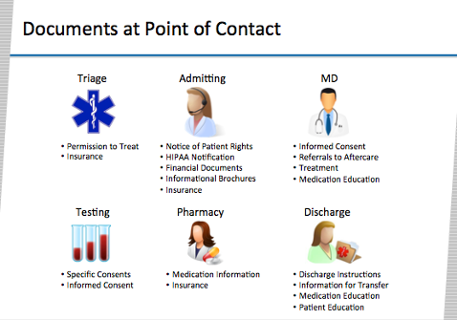
As a healthcare provider, the patient is always your main concern. Of course, the care you provide is also guided by laws and regulations. While some of these laws and regulations can make the jobs of doctors, nurses, pharmacists, and other providers more complicated, we can all agree that the majority of them help ensure that patients and healthcare professionals are protected, and everyone can access the same high-quality medical care when it’s needed.
When Translation Is the Law
An example of a legal requirement that benefits healthcare professionals and patients alike is the need to translate vital documents into the languages most commonly found in the area where a hospital or clinic is located. There are six vital documents that must be translated according to law. Title IV of the Civil Rights Act of 1964 prohibits discrimination based on national origin (among other things) by any organization receiving federal funding. Failure to provide necessary documentation in a language the patient can thoroughly understand can be considered discriminatory under the CRA. In 1997, the specific requirements for translation were clarified through the Critical Access Hospital Program, which focuses on those hospitals in areas of the country where the percentage of limited English proficient (LEP) patients is higher, and the relative number of adequate care facilities is low.
Six Vital Documents That Must Be Translated
According to these guidelines – which provide an excellent benchmark against which every hospital and medical practice can judge its own LEP language access protocol – there are six types of documents considered “vital” that must be made available in the languages common in the community where the facility is located. These include:
- Notices of free language assistance
- Notices of eligibility criteria for services
- Informed consent documents
- Intake forms that have clinical consequences
- Discharge instructions
- Complaint forms
Federal regulations set up and monitored by the Office for Civil Rights (OCR, part of the Department of Health and Human Services) require that these documents be translated for every “LEP language group that constitutes 5 percent or 1000 persons – whichever is less – of the population served.”
In some cases, state requirements are more stringent. For instance, in New York State, the law requires translated documentation for "LEP groups comprising more than 1 percent of the hospital service area.”
Section 1557 Requirements
Like the Civil Rights Act, Section 1557, the nondiscrimination provision of the Affordable Care Act, also requires organizations that receive federal funding to take reasonable steps to include the provision of language assistance services, including written translation. However, Section 1557 sets a new requirement that translators be qualified. Under Section 1557, organizations must now also post notices of nondiscrimination and taglines that indicate the availability of language assistance in the top 15 languages spoken by individuals with LEP in that state.
Covering Major Touchpoints in the Patient Experience
The list of vital document categories provides thorough coverage for a patient from triage to discharge and beyond. Every major touchpoint of the patient’s journey is included. The following graphic illustrates examples of specific forms that would fall into these categories and the touchpoints to which they connect.

Who Should Handle the Translation?
In some cases, hospitals have utilized bilingual staff to translate these and other documents into Spanish or other common languages in the areas where they serve. But is this the smartest strategy? Is the bilingual staff member indeed qualified to translate as required under Section 1557?
What if the resulting translation is not perfect? What if a slight error results in a miscommunication or completely faulty instructions being provided? Could your patient’s health or even life be at risk?
To avoid frustration, costly legal issues, and dangerous health outcomes, many health care facilities have opted to contract with a professional translation service using qualified translators to handle the translation of vital documents into necessary languages to serve the LEP patients that rely on them for care.
Doing so ensures that the patients receive the information they need to participate in their own treatment and make the most of the doctor’s instructions. It also frees up healthcare professionals to focus on their top priority – caring for the patient – without having to worry about unintentional miscommunications getting in the way of adequate care.
About LanguageLine®
LanguageLine has been the world leader in innovative language-access solutions since 1982. The company sets the global standard for phone, video, and onsite interpreting, as well as translation of the written word. LanguageLine is trusted by more than 30,000 clients to enable communication with the limited English proficient, Deaf, and Hard of Hearing communities. LanguageLine provides the industry’s fastest and most dependable access to more than 35,000 professional linguists in 290-plus languages — 24 hours a day, seven days a week, 365 days a year. Please do not hesitate to contact us.

